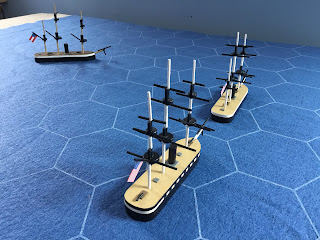The new cloth with a very familiar looking and somewhat theatrically staged scenario - familiar in that it is the set up of the game before last that I have yet to fight….
The arrival of my new blue hexed Hotz Mat has given me much to think about. It is going to be hugely useful for a variety of naval and aerial ideas and of course, given that the hexes are 4” across the flat sides it means that I can readily tap into the range of terrain pieces available from Kallistra in their Hexon range.
So where does this leave the square based ACW rules?
Where indeed.
I had always planned for the rules to be usable on both a square or a hexed playing surface with the former being my preferred choice - for two reasons really, the use of eight directions for movement etc and for the pure nostalgic value occasioned by the use of the old age of sail rules Ship ‘O the Line.
A close up for no other reason other than because I can….
Try as I might I have really struggled to get squares to work for the rules as written with the biggest issue being the use of diagonals. With the increase in complexity of weapons available and where they were fitted on a given ship I was having major issues trying to get firing arcs properly configured - an issue I never really solved satisfactorily. I am confident that the rules are pretty much a done deal systems wise but I am thinking that reverting to hexes will make life a whole lot easier and in many ways more relatable to their Gridded Naval Wargames forebears. To begin with firing arcs will be a whole lot easier to factor in. Reverting to hexes may seem like a seismic shift but in reality it would be very easy to execute and more importantly it would mean that I can get the rules finished far more easily!
It would be easy to say that perhaps I should have gone with hexes in the first place and saved myself a whole heap of effort but hindsight is a wonderful thing and besides, one should fully explore an option before discarding it.
In many ways this decision augurs well for future naval projects especially for the age of sail when I get to it. For rules for this period I could simply use those from Wooden Ships and Iron Men which were after all derived from the square based Ship ‘O The Line miniatures set.
For now though, I need to adjust the rules slightly and also look to get the remaining models built. For the latter what should be my final ACW model component order from Warbases has been duly submitted so work will resume in earnest once the bits and pieces have arrived.


4 comments:
David,
The new cloth looks great … and I can appreciate the rethinking you are doing with regard to your naval rules. I can see benefit for both squares and hexes, and both require compromises … but if you can produce a set of rules that work with both, you would have done very well indeed!
All the best,
Bob
Hi Bob,
For sure the rules can work with both hexes and squares but where the problems arise are with non broadside based weaponry - of which the ACW period had plenty! I suppose the land analogy of linear warfare working best on squares and more modern and fluid warfare using hexes could readily be translated into naval terms. The cloth does look good although I can see myself investing in a larger one in due course.
As soon as I put the models on the cloth (and yes, it does look rather nice!) I knew reverting to hexes was the way to go.
All the best,
DC
I have posted quite some thoughts on using various grids on my "Wargaming Mechanics" blog, see e.g. http://wargaming-mechanics.blogspot.com/p/table-of-contents.html
But there's no reason why you can't mix gridded and non-gridded mechanisms. Many gamers assume that once you use hexes or squares, everything has to be in hexes or squares, whether it's counting movement, counting ranges, fire arcs, etc. But I've played (skirmish) games in which movement and ranges are counted using the grid, and line of sight and facing/orientation is still determined by individual figures and terrain pieces.
Similarly, in a naval game, you could adjudicate movement by a grid, but exact orientation of the ship in the grid can still be continuous with the 90 or 45 or 60 degree tolerance (and hence orientation and firing arcs of weaponry as well).
I'm not saying this would work in your rules, and lots of it is a matter of taste and style as well, but not trying to squeeze everything into the grid framework can sometimes help, also in finding better alternative procedures.
Hi Phil,
You are absolutely right about mixing gridded and non-gridded mechanisms in the same rules. As I recall the board game Ironclads by Yaquinto did this for firing arcs. I have no problem with this per se but within the context of my rules I am deliberately keeping things ‘on the grid’ so to speak in order to preserve the ‘flavour of the original rules these were based upon (at least one of the sets in any event). I would probably be more inclined to try that if the ships occupied a single hex but as they cover two and being centrally located is a key requirement of facing etc, it makes sense to use the grid.
Thank you for your thoughts Phil - much appreciated.
All the best,
DC
Post a Comment